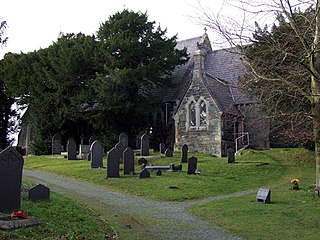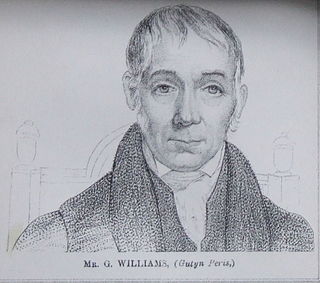Life
Williams was born in February 1739 in Ty Mawr, Trefdraeth, Anglesey from William ap Huw ap Sion, a stonemason. After a short time at school he served a seven years' apprenticeship to a saddler at Llannerch y Medd, where he associated with local bards including Hugh Hughes (Y Bardd Coch) and Robert Hughes (Robin Ddu o Fon). [1]
Moving to Llandygai, Carnarvonshire, he obtained occasional employment as clerk in the Penrhyn estate office, acting at the same time as land surveyor and dealer in slates. In 1782 he induced Lord Penrhyn to take over the slate quarries at Cae Braich y Cafn (later the Penrhyn Quarry), and was appointed quarry supervisor, a post he held until he was pensioned in 1803. He died on 17 July 1817, and was buried at Llandygai. [1]

George Sholto Gordon Douglas-Pennant, 2nd Baron Penrhyn, was a landowner who played a prominent part in the Welsh slate industry as the owner of the Penrhyn Quarry in North Wales.

The Penrhyn quarry is a slate quarry located near Bethesda, North Wales. At the end of the nineteenth century it was the world's largest slate quarry; the main pit is nearly 1 mile (1.6 km) long and 1,200 feet deep, and it was worked by nearly 3,000 quarrymen. It has since been superseded in size by slate quarries in China, Spain and the USA. Penrhyn is still Britain's largest slate quarry but its workforce is now nearer 200.

Edward Gordon Douglas-Pennant, 1st Baron Penrhyn, was a Scottish landowner in Wales and Jamaica, and a Conservative Party politician. He played a major part in the development of the Welsh slate industry.

Tregarth is a village near Thomas Telford's A5 London to Holyhead road between the town of Bethesda and the city of Bangor in Gwynedd, north Wales. It is in Llandygai Community. It had a population of over 1,300 as of the 2011 census..
This is a list of Sheriffs of Caernarvonshire.
This article is about the particular significance of the year 1850 to Wales and its people.
This article is about the particular significance of the year 1846 to Wales and its people.
This article is about the particular significance of the year 1785 to Wales and its people.
This article is about the particular significance of the year 1783 to Wales and its people.
This article is about the significance of the year 1776 to Wales and its people.
This article is about the particular significance of the year 1761 to Wales and its people.
Events from the year 1744 in Wales.
This article is about the particular significance of the year 1732 to Wales and its people.

Griffith Williams (1769–1838) was a Welsh language poet. He chose Gutyn Peris as his Bardic name.
George James Williams, known familiarly as Gilly Williams (1719–1805) was an English official, known as a wit and letter writer.
Samuel Williams was a British draughtsman and wood-engraver.
Robert Hughes (c.1744–1785) was a Welsh poet.

Robert Williams, bardic name Robert ap Gwilym Ddu (1766–1850) was a Welsh bard.
Joseph Windham (1739–1810) was an English antiquarian.

Hugh Hughes (Tegai) was a Welsh minister and poet.
This page is based on this
Wikipedia article Text is available under the
CC BY-SA 4.0 license; additional terms may apply.
Images, videos and audio are available under their respective licenses.
![]() This article incorporates text from a publication now in the public domain : Lee, Sidney, ed. (1900). "Williams, William (1739-1817)". Dictionary of National Biography . Vol. 61. London: Smith, Elder & Co.
This article incorporates text from a publication now in the public domain : Lee, Sidney, ed. (1900). "Williams, William (1739-1817)". Dictionary of National Biography . Vol. 61. London: Smith, Elder & Co.





